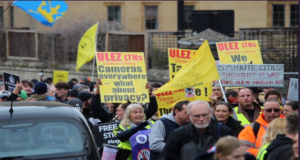In its desperate search for straws from which to fashion an election platform, the present UK government has turned to the motorists, hoping against hope that they will gather votes from the people who see in every Low Emission Zone, every Low Traffic Neighbourhood and every Congestion Charge, a global conspiracy foisted on us by the WEF, the UN, Bill Gates and George Soros .** For such people, neither facts nor reality are allowed to interfere with the interpretation of any restriction on the use of the car as a major assault on personal freedom. In London they claim that Low Emission Zones are nothing to do with pollution by particulates and nitrate oxides but are part of a secret net-zero agenda, and then undermine their own theory by pointing out (what would surely have been obvious to those undercover masterminds) that the London ULEZ allows unrestricted access to the ‘Chelsea tractors’ of the school run with far higher CO2 emissions than many smaller, but older, vehicles that are banned. In Oxford, they concatenate two quite different programmes, the one the imposition of a form of congestion control, the other, in other areas, the introduction of Low Traffic Neighbourhoods, then add in the idealistic concept of fifteen-minute cities, and from that heady mixture distil the idea that the council is proposing to lock people into their own neighbournoods for all but a hundred days a year. As if the council had the power to do so, even if, for some unexplained reason, it should wish to.

Street protest
It is all very silly, but they would have had one very silly ‘philosopher’ on their side.
In November 1970 Ayn Rand delivered a 57-minute lecture at the Ford Hall Forum in Boston. Her subject was “The Anti-Industrial Revolution and the Return of the Primitive” The theme of the lecture was the supposed existence of a movement identifying technology as mankind’s enemy and seeking to have it “restricted or abolished”. To make her point, she set about imagining what life would be like five years later, if the believers in that concept actually triumphed.
It was a curious vision, because in order to make it work, much of what was then modern technology had to be retained. It just had to be made to work badly. Private cars would be banned but buses, which use the same technology, would still exist. The bus companies, however, would be run incompetently. They would repeatedly fail to keep to schedules and would place their bus stops be miles apart. In doing so, they would be one of the main factors contributing to the plight of a young man struggling with life in the year 1975.
“You are married, have two children and own a modest home in the suburbs of a large city. You get up at five a.m., because you work in the city and must be at the office at nine. …….. When you had a car, it took you three-quarters of an hour to get to the office; but private automobiles have been outlawed and replaced by “mass transportation.” Now it takes you two hours and a half. The community bus can make the trip in a little over an hour, when it is on time; but you never know whether it will be on time, so you allow for half-an-hour’s delay. You trudge ten blocks through the bitter gusts of a cold morning wind to your community bus stop, and you stand waiting. You have no choice — there are no other means of transportation — and you know it; so does the bus company.
When you reach the city, you walk twelve blocks from the bus terminal to the office building.”
The first thought that springs to mind is that having to use ‘the community bus’, or some other mass transport system, would have been the fate of many in the real USA of 1975. Not everybody who commuted from the suburbs to the city centre would have had a car, and certainly not the two cars implied later in the lecture, when Rand bewails the fate of the wife who had to walk two miles to the nearest grocery store, and two miles back, carrying the groceries. She had to do this, it seems, because there were no shopping centres and, contrary to all experience of places that lack such things, hardly any shops either.
The second thought is that, then as now, unless you had a reserved parking space, you would be mad to use a private car (selfishly depriving your wife of it) to commute to the city centre. That is certainly true of any of the big cities in which I have lived and worked (London, Hong Kong, Melbourne, Sydney, Jakarta). In Sydney there were many options. Many people used buses, I used the train, others used ferries (as I did in Hong Kong). Rand’s imagined car journey may have taken only 45 minutes, but how long then did it take her poor wage slave to find somewhere to park? Even the British government has recognised that as a problem, although not one to which they have any plausible solution. In reality, this part of Rand’s tirade had nothing to do with technology, but with her lifelong obsession with the superiority of individual provision (one person, one car) over public provision. It was not the bus she hated, it was the community bus!
Truly, she was very stupid.
**It is interesting to note that the very worst thing a billionaire can do, if he wants to avoid universal condemnation, is try and do something useful with his money.
